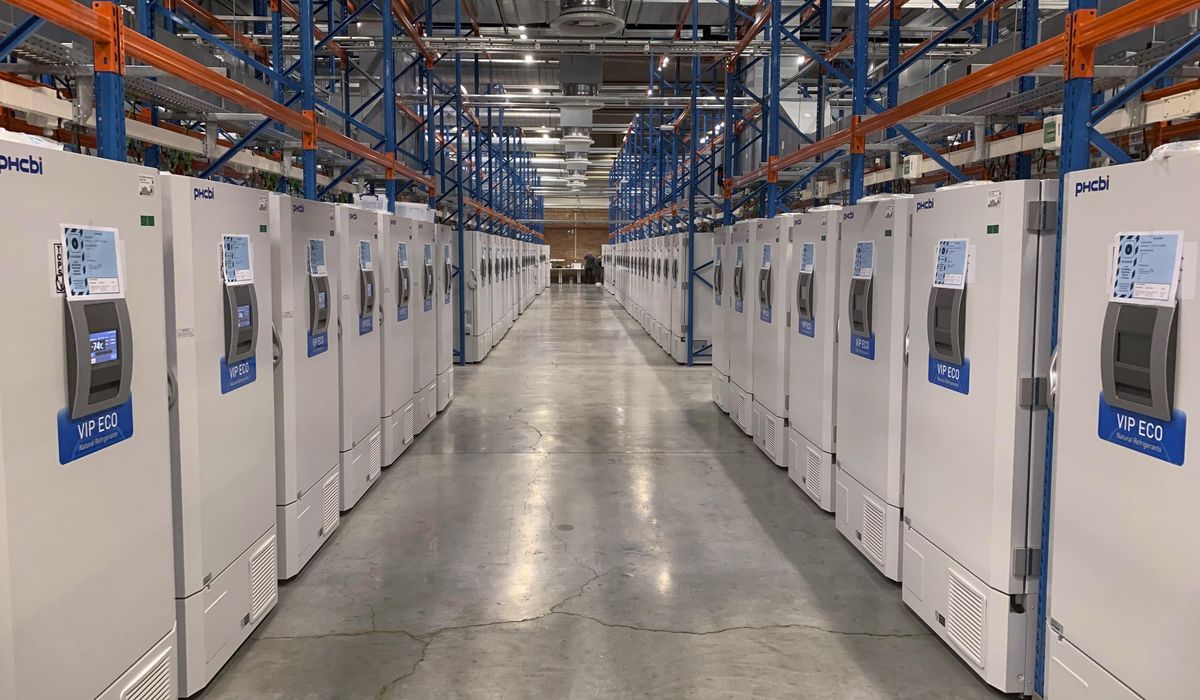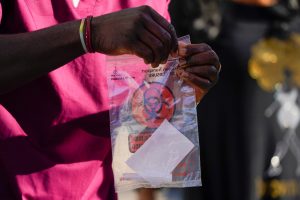The federal government wants to get a COVID-19 vaccine into the arm of every American who wants one by spring, but it faces steep hurdles, including fulfilling the high demand and shipping vials at temperatures so low that they require special boxes, dry ice and careful handling to ensure doses aren’t wasted.
Drugmaker Pfizer thrilled the world by declaring its vaccine was 90% effective in a preliminary analysis, putting it on track to request emergency approval this month. Moderna is expected to release data shortly, and other front-runners are steeped in late-stage trials, meaning multiple vaccines could be available in the new year.
“Help is really on the way. If you think of it metaphorically, the cavalry is coming here,” Dr. Anthony Fauci, director of the National Institute of Allergy and Infectious Diseases, told ABC’s “Good Morning America” on Thursday. “Vaccines are going to have a major positive impact.”
That doesn’t mean it will be easy.
The messenger-RNA vaccines from Pfizer must be shipped at minus-94 degrees Fahrenheit in special boxes, or “thermal shippers,” which can be used as temporary storage. It’s a nifty innovation, but not one that has been tested in the field.
Most of the investigational vaccines, including Pfizer’s, require a second dose, complicating and elongating the rollout. Plus, tens of millions of essential workers, seniors and those with underlying health conditions are slated to be inoculated in priority phases, making the White House’s push for publicly available shots by April a heavy lift.
“I think that’s an aspirational goal,” said Dr. William Schaffner, an infectious disease specialist at Vanderbilt University. “The companies tell us they can manufacture a lot, and we’ll see if all that works out.”
Cold realities
Pfizer’s efficacy announcement Monday solidified its position as the front-runner in the race for a vaccine. But the company has another distinction: Its doses require super-cold storage and transport.
The company set up its own logistics plan instead of using the federally contracted distributor, McKesson.
Pfizer will ship the vaccines in “specially designed, temperature-controlled” boxes by air to major hubs, from which they will travel by ground to sites where they will be administered. The boxes contain GPS-enabled thermal sensors so Pfizer can track their locations and temperatures.
Vaccination sites have three options for storage: using freezers that can reach minus-94 degrees and extending shelf life for six months, storing doses for up to five days in common refrigeration, or using the thermal-shipper box carrying the doses when they arrive.
The shippers can maintain doses for 10 days. Once opened, they need to be replenished with dry ice every five days for up to 15 days of additional storage. The vaccines can degrade and become less potent if the boxes are left open or not handled correctly, so providers are seeking more detailed training information.
“The question is, can it be idiot-proof enough you can put it in large-chain pharmacies? It’s a lot to ask,” said Paul Offit, a pediatrics professor at the University of Pennsylvania and a member of the Food and Drug Administration’s vaccine advisory panel.
Dry ice can be dangerous, and regions may face shortages once there is a rush on local supply.
“Providers have never worked with dry ice in their lives. This is just a very novel storage situation,” said Litjen Tan, chief strategy officer for the Immunization Action Coalition.
Each box has a minimum of 975 doses, so another question is whether less-populated parts of the country can use all their doses under the time constraints.
“Rural areas are going to have a challenge because there’s going to be vaccine wasted,” Dr. Tan said.
The Centers for Disease Control and Prevention advised states not to rush to buy expensive ultra-low temperature freezers because distribution sites hope to administer doses quickly after receiving them. Yet rural states such as North Dakota will probably invest in some centralized deep-freeze storage so they can serve far-flung areas with some doses without wasting the rest of the batch, said Claire Hannan, executive director of the Association of Immunization Managers.
“States are going to just figure it out and handle it in different ways depending on the geography in their state,” Ms. Hannan said.
Pfizer said it does not have a breakdown of which methods each state plans to use. In a statement, the company described its planning as “detailed” and designed to ensure vaccines arrive swiftly and under the right conditions.
“Our distribution is built on a flexible just-in-time system which will ship the frozen vials to the point of vaccination,” the company said. “We have also developed packaging and storage innovations to be fit for purpose for the range of locations where we believe vaccinations will take place.”
Return visit
Five of the six leading vaccine candidates supported by Operation Warp Speed require two doses. They aren’t interchangeable, so each person must receive the same version on their second visit.
The Department of Health and Human Services said only half of the available doses will be sent to distribution sites initially to ensure supply is available for follow-up doses 21 or 28 days later.
Also, “this prevents administration sites from having to manage and store second doses,” the agency said. “Sites will also be provided vaccination reminder cards to provide every person, and administration sites are leveraging existing systems to text and email reminders.”
The shingles vaccine, Shingrix, requires two doses, so doctors have experience in ensuring that patients return. They are trained to warn recipients about soreness, fever or headaches from the shots. The same will apply with the COVID-19 vaccine.
“You really have to prepare people for that and persuade them to come back for the second dose so they don’t think that’s unusual,” Dr. Schaffner said of the irritating side effects.
Drugmaker Johnson & Johnson is conducting a massive late-stage trial of its single-dose vaccine, though its timeline is not as far along as some of the other companies.
In the meantime, states and the federal government are using software and other systems to make sure people know when to return for a second dose.
“The second shot will be scheduled at the time they get the first shot,” Pennsylvania Health Secretary Rachel Levine said at a recent briefing. “We’ll have a tracking system if they don’t come, to make sure that they’re notified to come back and get that second shot.”
Aspiring for April
President Trump’s Operation Warp Speed has spent more than $10 billion to expedite pharmaceutical solutions to the COVID-19 pandemic, which has upended normal life and is only getting worse, with the U.S. recording more than 100,000 new cases and 1,000 deaths per day.
Mr. Trump was disappointed that Pfizer didn’t release promising data on its shots until after the election. Though he is slated to leave office before the vaccination campaign concludes, his administration is touting a rollout that would make shots widely available by March or April.
Pfizer says it will be able to deliver 100 million doses, enough for 50 million people, to the U.S. by March. The country needs more to meet its ambitious goals, so that’s where other companies come in.
“I think it’s the only way to do it, really, is to have more than one vaccine,” Dr. Offit said.
The U.S. government struck deals to secure millions of doses upon approval, giving drugmakers an incentive to keep producing. Whether there is enough supply after the initial rollout to hit the April target remains to be seen, though the administration sounds confident.
“Not only has manufacturing work begun, it’s begun on an industrial scale for all six OWS-supported vaccines,” Health and Human Services Secretary Alex Azar wrote in a Fox News op-ed. “More than 23 manufacturing facilities across the U.S. have already been augmented and scaled up with support from [Operation Warp Speed].”
Mr. Azar said Thursday that HHS has partnered with 60% of the pharmacies in the U.S., including CVS, Walgreens and Rite-Aid, to assist the vaccination campaign.
Whether the vaccination effort succeeds rests on the shoulders of Gen. Gustave Perna, formerly of the Army Materiel Command. He told CBS’s “60 Minutes” that the buck stops with him.
“Me. Conversation’s over. It’s pretty easy — me,” Gen. Perna said on the program. “I hold myself 100% personally accountable to that end.”
An outbreak of COVID-19 in Danish minks and various strains of the virus from China and Europe have raised questions about the staying power of the vaccines.
Dr. Schaffner said the critical spike protein of the virus has been “very, very stable” in samples so far, giving scientists hope that a variety of vaccines will produce an immune response and work consistently.
Who’s up first?
The Advisory Committee on Immunization Practices, hosted by the CDC, is developing recommendations for states to determine which groups will get the first batches of vaccine.
A CDC presentation to the advisory committee showed three priority groups: 53 million Americans older than 65, 100 million with high-risk medical conditions and 80 million essential workers, including 20 million in health care. There is substantial overlap between the groups, so it’s difficult to pin down the exact number of high-priority Americans, though a viewpoint paper in the Journal of the American Medical Association puts it at around 200 million.
Some experts say the overall number could be lower, though states are gaming out which groups will get the first batches.
Louisiana officials are planning a remote exercise this week to figure out how it would allocate a smaller-than-expected supply. Public health officials in Philadelphia are counting the number of health care workers who would be first in line, according to The Associated Press.
If initial supply doesn’t match expectations, then health care workers are poised to be the first in line, likely at specialized clinics. They would be followed by essential workers outside the health care industry, people with high-risk medical conditions and those older than 65.
The Advisory Committee on Immunization Practices could rank the second groups once a vaccine is approved or let states determine how to do it based on their populations.
Ms. Levine told stakeholders this week that Pennsylvania will be ready.
“We will be prepared when we get the ball,” the state’s health secretary said this week. “When we get the vaccine, we’re going to have all of those distribution plans laid out.”



















